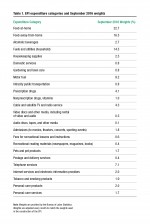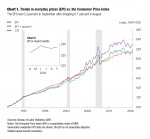Rising Gas Prices Nudge Everyday Prices Higher for September
AIER’s monthly Everyday Price Index rose 0.2 percent in September, driven by a 2.3 percent jump in gasoline prices. Over the past 12 months, the index has fallen 0.1 percent.
The EPI including apparel, a broader measure, rose 0.4 percent in September and has fallen 0.1 percent over the past 12 months.
The Everyday Price Index measures price changes that people see in their everyday purchases, such as groceries, gasoline, utilities, and personal-care services. It excludes infrequently purchased, big-ticket items (such as cars, appliances, and furniture) and prices that are contractually fixed for prolonged periods (like housing).
The more widely known price gauge, the Consumer Price Index reported by the U.S. Bureau of Labor Statistics, rose 0.2 percent for the month prior to seasonal adjustment and moved 1.5 percent higher over the past 12 months. The EPI is not seasonally adjusted, so we compare it with the unadjusted CPI.
In the September EPI, gasoline prices rose 2.3 percent after dropping for two consecutive months. Household energy prices also rose, with prices for utilities up 0.7 percent and home heating oil up 2.3 percent. The rise in gas prices was supported by domestic crude-oil production stabilizing and crude inventories shrinking. Domestic crude production has stabilized at 8.4 million barrels a week from a peak of 9.5 million barrels a week in 2015. Crude inventories dropped to 467 million barrels in September from a record high of 509 million barrels in May. The result has been a near doubling in crude-oil prices to $50 a barrel from $26 a barrel last fall.
For many Americans autumn means flannels, football, and yard work. Modest price changes for lawn-care products and services have helped household budgets. Prices for outdoor maintenance equipment and supplies have fallen 0.7 percent over the past year, in line with their long-term decline, and waste removal prices rose only 1.3 percent over the past year, below their historical growth rate of 3.1 percent. For households that hire lawn care services, prices have increased only 1 percent over the past 12 months, well below their 15-year growth rate of 2.7 percent.
Looking ahead, prices for lawn care services may rise if the costs of doing business—gasoline and labor—rise. Wages for landscapers have jumped 3.2 percent over the past year, faster than the 2.5 percent average seen over the past five years. If this continues, and gas prices continue to rise, consumers will face higher prices if lawn-care services pass on higher energy and labor costs.






